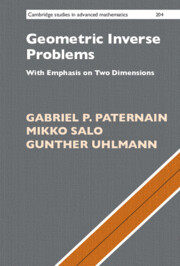
-
Select format
-
- Publisher:
- Cambridge University Press
- Publication date:
- January 2023
- January 2023
- ISBN:
- 9781009039901
- 9781316510872
- Dimensions:
- (229 x 152 mm)
- Weight & Pages:
- 0.71kg, 370 Pages
- Dimensions:
- Weight & Pages:
- Series:
- Cambridge Studies in Advanced Mathematics (204)
You may already have access via personal or institutional login- Series:
- Cambridge Studies in Advanced Mathematics (204)
Book description
This up-to-date treatment of recent developments in geometric inverse problems introduces graduate students and researchers to an exciting area of research. With an emphasis on the two-dimensional case, topics covered include geodesic X-ray transforms, boundary rigidity, tensor tomography, attenuated X-ray transforms and the Calderón problem. The presentation is self-contained and begins with the Radon transform and radial sound speeds as motivating examples. The required geometric background is developed in detail in the context of simple manifolds with boundary. An in-depth analysis of various geodesic X-ray transforms is carried out together with related uniqueness, stability, reconstruction and range characterization results. Highlights include a proof of boundary rigidity for simple surfaces as well as scattering rigidity for connections. The concluding chapter discusses current open problems and related topics. The numerous exercises and examples make this book an excellent self-study resource or text for a one-semester course or seminar.
Reviews
‘This monograph gives a beautiful introduction to Geometric inverse problems, largely in dimension two, by three of the most prominent contributors to the field. The Geometric problems are interesting as pure mathematics, but they also arise from applications to tomography, such as the Calderon problem of determining (M, g) from its Dirichlet-to-Neumann map. Roughly speaking, the underlying physics problem is to determine electrical properties of a medium by making voltage and current measurements on the boundary. Techniques of microlocal analysis relate such PDE boundary inverse problems to geometric inverse problems. These inverse problems furnish problems of great interest in PDE and in geometry in a rather concrete setting, and are masterfully conveyed by the authors. The level is appropriate for a graduate class in mathematics but is also an excellent entrée into the field for research mathematicians.’
Steve Zelditch - Northwestern University
Contents
Metrics
Altmetric attention score
Full text views
Full text views help Loading metrics...
Loading metrics...
* Views captured on Cambridge Core between #date#. This data will be updated every 24 hours.
Usage data cannot currently be displayed.
Accessibility standard: Unknown
Why this information is here
This section outlines the accessibility features of this content - including support for screen readers, full keyboard navigation and high-contrast display options. This may not be relevant for you.
Accessibility Information
Accessibility compliance for the PDF of this book is currently unknown and may be updated in the future.


